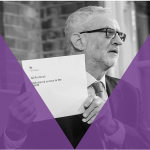
Dr Mike Berry
Senior Lecturer at Cardiff University School of Journalism, Media and Cultural Studies.
Email: BerryM1@Cardiff.ac.uk

Section 4: Parties and the Campaign
- Something old, something new, something borrowed, something EU
- ‘Weak and wobbly’ to ‘get Brexit done’: 2019 and Conservative campaigns
- Conservative victories in Labour heartlands in the 2019 General Election
- More Blimp, less Gandhi: the Corbyn problem
- Corbyn and Johnson’s strategic narratives on the campaign trail
- The Brexit Party’s impact – if any
- Down a slippery rope… is Britain joining the global trends towards right-wing populism?
- Farage: losing the battle to win the war
- Party election broadcasts… actually?
- GE 2019: lessons for political branding
- The postmodern election
Prior to the 2017 General Election, party manifestos were seen as relatively insignificant in influencing voting behaviour. However, this changed in 2017 when the Labour and Conservative manifestos played an important role in the Tory party losing its majority. Labour’s bold manifesto, with its pledges to nationalise the railways and energy companies, raise the minimum wage and end tuition fees caught the public imagination, whilst the Conservative’s uncosted offering, with its unpopular ‘dementia tax’, damaged the party’s campaign.
But in the 2019 election, Labour was not able to repeat the trick with its even more radical manifesto. Meanwhile, the Conservatives’ ‘small target’ approach meant that their manifesto did not impact the significant poll lead the party brought into the election.
Why was Labour’s 2019 manifesto unable to resurrect the party’s fortunes as it had in 2017 – especially since polling indicated key policies were individually popular? To answer that question, five key factors were important.
First, negative perceptions of the party leadership influenced how people viewed its policy offerings. Policies may be popular, but if the public don’t like or trust the party to deliver them, then they won’t be seen as credible. In 2017 Jeremy Corbyn was more of an unknown quantity, fought a good campaign and saw his approval ratings rise substantially. But he came into the 2019 election with record low approval ratings and although these improved during the campaign, they remained well below his 2017 levels. Reports from canvassers suggests that sustained negative mass media coverage and ‘dark advertising’ from front groups were crucial, with voters citing key media attack lines – such as support for terrorists, antisemitism and that he would bankrupt the country- in explaining why they disliked the Labour leader.
Second, the manifesto was negatively reported in the press and broadcast media. The right-wing press provided false and misleading accounts of how much the manifesto would cost. Broadcasting relied heavily on the IFS who argued that the manifesto costings were ‘not credible’. Despite many economists supporting Labour’s approach – these views weren’t featured in the BBC’s mass audience bulletins. Instead those television bulletins – and radio shows like ‘PM’ – only cited as an external source the IFS, whose negative framing of the manifesto predominated and was later weaponized in Conservative attacks ads.
Third, the manifesto was too big and insufficient time and effort had been put into preparing the public for its more radical elements. Rather than a tight, focused offering with a few eye catching and popular proposals, the manifesto contained a cornucopia of retail offers which – in combination – voters found implausible. Furthermore, the ideological ground hadn’t been prepared to allow the more radical elements – like major public investment in a Green New Deal or free broadband – to resonate with voters. Such policies needed to be grounded in a narrative stressing the key role of an interventionist state and the importance of universalism – both approaches that marked a fundamental break with previous Conservative and New Labour governments. You cannot prepare the public for such a fundamental shift in a few short weeks. It requires a sustained programme of public education over many years. The creation of a mass membership party in 2015 offered Labour an opportunity to mobilise its supporters to explain the need for such policies, in face to face conversations and the more open spaces in broadcast media. It was an opportunity that was not taken.
Fourth, Labour faced the problem that over the preceding decades much of the public had lost faith in the ability of politicians and the state to institute major social change that would improve their lives. Canvassers reported a deep sense of ‘nihilism’ and ‘resentment’ – ‘Policy doesn’t matter here. They’ve forgotten what government can do’. Furthermore, as Ramsay notes, the Conservative campaign with its ‘key meme’ that ‘you can’t trust any of them’ was intended to breed cynicism about potential change and ‘drive down turnout among those who would benefit most from progressive policies’. This is not an environment where a manifesto offering radical social change could easily take root.
Finally, the credibility of the manifesto was damaged by the inability of Labour politicians to explain how it would be paid for. When this question was put to Nia Griffiths on an episode of Any Questions (22 November) she was unable to provide a clear answer. Even more damaging was Jeremy Corbyn’s evasiveness when Andrew Neil asked how the major pledge to the WASPI women would be funded. Labour always faces a hostile media much of it deeply opposed to a larger state. In such an environment, it has to be able to defend its spending commitments in a convincing manner.
